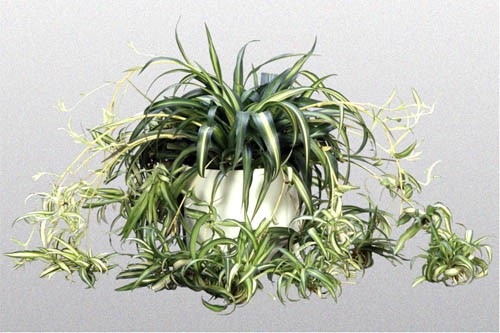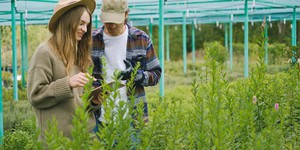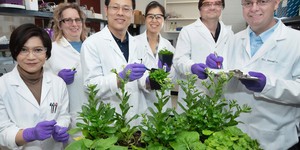Abstract
Did you know that apple trees do not "breed true"? This means that if you plant seeds from an apple, say a Granny Smith, you will get apple trees, but they will make apples that are actually different than Granny Smiths. So how do farmers produce new Granny Smith trees? They use a method called vegetative propagation. For instance, they may cut a branch off of a tree that grows Granny Smith apples and attach the branch onto a different tree trunk. This method of making new trees is called vegetative, or asexual propagation because the tree was not produced by the usual mixing of pollen (male) and ovule (female) to form a seed. In this plant biology science fair project, you will investigate the factors that influence the success of vegetative propagation, using the popular spider plant.Summary
David Whyte, PhD, Science Buddies

Objective
The objective of this plant biology science fair project is to determine how different growth media affect the development of roots in newly propagated plantlets.
Introduction
You probably think there is only one way to grow a new plant, right? By planting a seed in the ground. However, there are actually two ways to propagate (grow) plants: the seed method (sexual) and the vegetative method (asexual). The growth of new plants from seeds, or from parts of existing plants, is called plant propagation. The seed method of plant propagation is referred to as sexual propagation, because the resulting plant contains genetic material from both parent plants. Vegetative propagation, on the other hand, is reproduction through the use of vegetative parts of a plant, such as portions of the stems, roots, or leaves.
Both types of propagation are used in the reproduction of the familiar fruit and vegetable plants you buy at the grocery store. Most deciduous fruit trees, commercial nut trees, grapes, small fruits, and ornamental shrubs are propagated asexually, whereas most vegetable and field crops are propagated sexually, from seeds. Both types of propagation are also found in nature. Oak trees reproduce sexually, with the acorn resulting from the union of male and female genetic material. Redwood trees, on the other hand, can reproduce asexually, with new trees sprouting from the base of older, more established trees.
In asexual propagation, all of the plants that are produced from a parent tree are genetically identical. In fact, many of the plants used commercially are clones of each other. An advantage of this is that the fruit produced by the plants are always the same as the parent plants'. There are several ways to propagate plants asexually. These include using cuttings, layering, grafting and division. To propagate by cutting, a part of the plant is cut off of the parent plant and placed in soil or other growth medium to grow. Remarkably, a whole new plant, roots and all, can be regenerated from a cutting made from just part of a branch or leaf! In layering, a branch from the parent plant is buried, while still attached to the parent and growing. Whole new plants grow from the part of the branch that is buried. In grafting, a branch, or cluster of branches, from one type of plant is grafted onto another plant. In some cases, the whole part of the plant above the ground, including leaves, branches, and fruit, can be grafted onto the trunk of another kind of plant. California grapes, for example, typically have roots from one kind of plant and grapes from another kind. The roots are chosen for their resistance to pests and the fruit is selected for its commercial value.
In this science fair project, you will investigate factors that are important for the successful propagation of spider plants (Chlorophytum). Spider plants make miniature duplicates of the mother plant that hang at the end of curved stems, or stolons. The miniature duplicates are called offsets or plantlets. Spider plants can be propagated by removing the plantlets from the stolons and potting them separately, or by simply putting them in a glass of water. They can also be grown while still attached to the parent plant. This is a form of propagation by division. You will investigate how the growth medium—potting soil, vermiculite, or water—affects plantlet root growth.
Terms and Concepts
- Seed (sexual) plant propagation
- Vegetative (asexual) plant propagation
- Plant propagation
- Vegetative parts of plants
- Cutting
- Medium
- Layer
- Graft
- Spider plants (Chlorophytum)
- Stolon
- Offset
- Plantlet
- Plant division
- Media
Questions
- What are some advantages of vegetative vs. seed propagation?
- In what part of the world did spider plants originate?
- How does plant cloning compare to animal cloning?
Bibliography
- Mary Ann Gowdy. (2002). Home Propagation of House Plants. Retrieved January 12, 2009.
- Ohio State University. (1998). Plant Propagation. Retrieved January 12, 2009.
Materials and Equipment
- 12-ounce (oz.) StyrofoamTM cups, to be used as potting containers (9)
- Masking tape
- Permanent marker
- Soilless potting mix, sterile (1 bag); available at any plant nursery
- Vermiculite (1 bag); available at any plant nursery
- Water, tap
- Bases for potting containers, such as small plastic plates or bowls
- Spider plant; available from a plant nursery. It should be healthy and have lots of plantlets hanging from it.
- Rubbing alcohol
- Scissors
- Scale, accurate to 1 gram (g), such as the digital pocket scale from Amazon.com
- Pencil
- Ruler
- Plastic bags, 1-gallon (9)
- Magnifying glass
- Watering can, 1-gallon
- Lab notebook
- Graph paper, or graphing software
- Helper
Disclaimer: Science Buddies participates in affiliate programs with Home Science Tools, Amazon.com, Carolina Biological, and Jameco Electronics. Proceeds from the affiliate programs help support Science Buddies, a 501(c)(3) public charity, and keep our resources free for everyone. Our top priority is student learning. If you have any comments (positive or negative) related to purchases you've made for science projects from recommendations on our site, please let us know. Write to us at scibuddy@sciencebuddies.org.
Experimental Procedure
Planting Your Cuttings
-
Label three containers, using the masking tape and permanent marker, as follows:
- Sterile potting mix. Date:___
- Vermiculite. Date:___
- Water. Date:___
- It is important to include the date, as you will be staggering the start dates.
- Fill the labeled plant containers with the appropriate planting media. Leave about 3 cm of space at the top. Two pots should have solid media, the other should just have water.
- Poke three small holes in the bottom of the containers that are holding the potting soil and the vermiculite, for drainage. Keep them on bases, such as small plastic plates or bowls.
- Water the potting mixture and the vermiculite. Add water so that the growth medium is moist, but not saturated. Allow it to drain completely.
-
Record the entire procedure in your lab notebook.
- Make a data table showing the type of planting media and the date.
-
Cut off three plantlets from the spider plant.
- Prior to cutting, sterilize the scissors with rubbing alcohol.
- Use the scissors to cut each stolon (stem) attached to the plantlet.
- Use the ruler to measure the length of the leaves on each plantlet. Record the leaf length in your lab notebook.
 Image Credit: David Whyte, Ph.D., Science Buddies / Science Buddies
Image Credit: David Whyte, Ph.D., Science Buddies / Science Buddies
Figure 1. Spider plant. Note the plantlets hanging from the "mother plant."
- Create a 1-cm hole in both of the solid planting media with a pencil.
- Carefully place the base of one plantlet into each hole you made in your planting media and gently push in the growth medium around them.
- Place the third plantlet in the cup with water. Place it so that base of the plantlet is in the water and the sides of the container support the foliage.
- If the plantlet is too small for the container, use a smaller container.
- Place a plastic bag over each container. The bags will keep the humidity high and hold in heat. Note: Do not seal the bags completely, as you want to allow some airflow.
- Place the containers with the plantlets in a warm area with indirect lighting.
- Don't put them into full sunlight until new growth appears and they can be removed from the bag.
- Repeat steps 1–15 two more times, on different days, so that you have three sets of plants growing.
Caring for the Plants
- Check your plants regularly. If there is condensation in the bags, remove the bags temporarily to let the plant dry out.
- Keep the solid media moist, but not saturated.
- When the roots of the plantlet that is in the water are about 2 inches long, check for roots in the plants in the solid media by tugging gently on the cuttings and testing for resistance. If no roots have formed, or if they are very small, put the cutting back into the media, recover it with the plastic bag, and check for roots again in 1–2 weeks.
-
Once the cuttings have developed roots, they are ready to be analyzed.
- Use your judgment about when to start processing (measuring and observing) the plants. Ideally, all of the plants should have developed roots. But if most of the plants have developed roots and some fail to grow, go ahead with the processing of the growing plants. Record all observations, including those about the plants that did not grow, in your lab notebook.
Analyzing the Plants
- Process the plants after an equal period of growth. For example, if you started three sets of plants on three consecutive days, perform the weighing and other processing on three consecutive days, too. See the Science Buddies page, Measuring Plant Growth for more information about how to measure your plants.
- Record the number of plants that were successfully propagated in each of the growth media.
- Record the height of each plant.
- Record the leaf length for each plant.
- Determine the change in the leaf length for each plant.
- Pull the plants that are in the solid media out of the soil and look at the root systems.
- Make notes in your lab notebook about your observations. Are the roots dense or thin?
- Rinse the roots out thoroughly in running water.
- Dry the plants.
- Count the number of roots on each plant.
- Weigh each plant on the kitchen scale.
- Repeat steps 2–11 for the rest of the trial sets on the appropriate day.
- Graph your data, showing the kind of planting mix on the x-axis. Graph the number of plants that grew, the average height, the change in the leaf length, the number of roots, and the plant weight.
- Did the kind of growth medium affect the ability of the plantlet to form roots?
Ask an Expert
Global Connections
The United Nations Sustainable Development Goals (UNSDGs) are a blueprint to achieve a better and more sustainable future for all.
Variations
- Repeat the procedure above, but use more plantlets.
- Based on your observations, choose other criteria for how the plants are growing and add this data to your analysis.
- Compare different kinds of water; for example, tap, distilled, deionized, and bottled. You can find out the mineral content of your tap water from your local water purification agency.
- Does adding fertilizer to the growth media affect the rate of growth of the roots?
- Observe the roots with a magnifying glass and record your observations (look for root hairs).
- Compare growth of plantlets that have been cut from the mother plant and plantlets that remain attached to the mother plant.
- Measure the length of the roots. Graph the average and maximum root length, along with the other data.
- Vary the time at which you process the plants. For example, start 12 plantlets in sterile potting soil and process the plants at 1 week, 2 weeks, 3 weeks, and 4 weeks (three plants at each time point). Graph the plant height, plant weight, and root count vs. time.
- Repeat the procedure above, but use leaf cuttings instead of stem cuttings. The websites in the Bibliography have procedures for leaf cuttings.
- Try other kinds of plants. Most house plants can be propagated be cuttings.
- Try other growth media, such as soil from your backyard, or sand.
- Devise a way to propagate the cuttings hydroponically. That is, grow them in water with nutrients and minerals, without soil. What nutrients, salts, etc. are needed for the cuttings to form roots?
Careers
If you like this project, you might enjoy exploring these related careers:
Related Links
- Science Fair Project Guide
- Other Ideas Like This
- Plant Biology Project Ideas
- My Favorites
- Measuring Plant Growth









